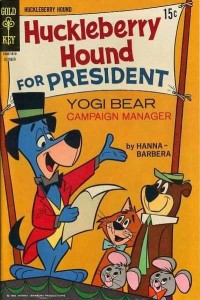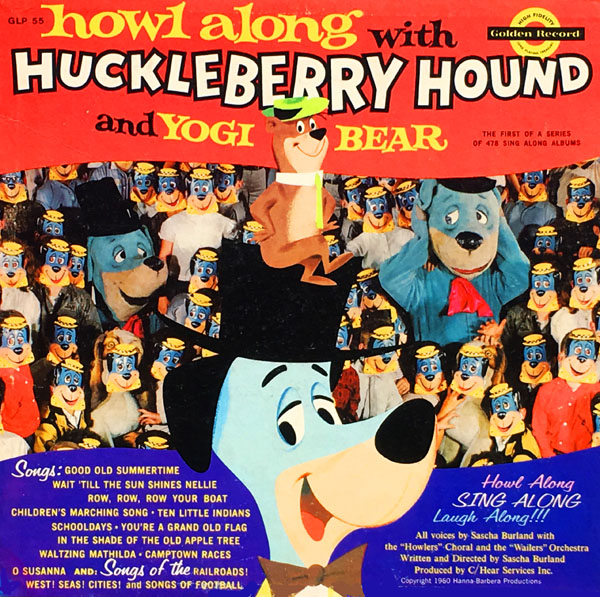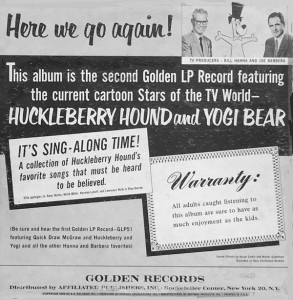Madison Avenue songsmith Sascha Burland produced the most sophisticated Hanna-Barbera-licensed record ever when Huck ran for President in 1960.

HUCKLEBERRY HOUND FOR PRESIDENT
The Making of a Candidate or True Democracy in Action
A.A. (Golden) Records (12” 33 1/3 RPM / Mono / 1960)
Executive Producer: Arthur Shimkin. Writer/Producer/Director: Sascha Burland. Recorded at Nola Penthouse Studios, New York. Running Time: 42 minutes.
Voices: Kenny Delmar, Mason Adams, Mort Marshall, Herb Duncan, Joe Silver, Pete Waldron, Lynn Nola, Bob Marcato.
Sequences: “The People’s Choice,” “T.V. or Not T.V.,” “Madison Avenue,” “Search for a Campaign Song,” “Tippecanoe and Tyler Too,” “Do Do My Huckleberry Do!” “Speech! Speech!” “We Like Huck,” “Horse Flats, Whistle Stop,” “The Big Show.”
 Many may not be aware that The Huckleberry Hound Show, though aimed primarily at kids, had a wit that appealed to adults. An Emmy winner, the show had a grownup following much like that of Beany & Cecil, Kukla, Fran & Ollie and The Soupy Sales Show. In 1960, when both the presidential race and the comedy album boom were in full force, writer Sascha Burland produced a very unique album that combined them all.
Many may not be aware that The Huckleberry Hound Show, though aimed primarily at kids, had a wit that appealed to adults. An Emmy winner, the show had a grownup following much like that of Beany & Cecil, Kukla, Fran & Ollie and The Soupy Sales Show. In 1960, when both the presidential race and the comedy album boom were in full force, writer Sascha Burland produced a very unique album that combined them all.
Burland was a highly successful advertising creative, whose most famous piece of music accompanied Alka-Seltzer’s long-running “Whatever Shape Your Stomach’s In” campaign. The song gained a life of its own as an instrumental hit by “The T-Bones.” He also wrote the mid-‘60s theme for the game show, What’s My Line?
His other claim to fame was a novelty recording act called The Nutty Squirrels, a jazz twist on The Chipmunks. The group recorded several albums, had a hit with a song called “Uh-Oh” and even dabbled in animation.
Burland’s co-writer on “Stomach” and “Uh-Oh” was Don Elliott a renowned jazz musician/singer/composer who participated in several Golden Records in the late’50s/early’60s, including a 45 rpm version of the themes from Peter Gunn and 77 Sunset Strip. You can hear the same jazz influence—and most likely the same musicians—on this record.
Most of the actors on this album are also icons of early’60s advertising, radio and animation in New York, including Mort Marshall (Klondike Kat, Tennessee Tuxedo), Herb Duncan (The Milton the Monster Show, The Jetsons Golden LP) and Joe Silver (Raggedy Ann & Andy: A Musical Adventure). Mason Adams plays the most roles, opening and closing the LP as “Bert,” who chats with “Harry” in a bar (which instantly sets this apart from a children’s record). The inside joke of their names is that Bert and Harry Piels were very popular characters from a series of beer commercials featuring the legendary Bob and Ray.
 Bert asks for the TV to be turned on, and there are raucous political speeches, including one by Kenny Delmar in his “Senator Claghorn” voice. When Harry changes channels, The Huckleberry Hound Show appears on several stations. This is the only time a vinyl recording included the actual Huckleberry Hound soundtrack TV theme–albeit a chopped-up presentation, which is a shame. It was never included on any other Golden, Hanna-Barbera or Colpix record. The theme music, played on a solo clarinet, is also repeated as a musical bridge between sketches.
Bert asks for the TV to be turned on, and there are raucous political speeches, including one by Kenny Delmar in his “Senator Claghorn” voice. When Harry changes channels, The Huckleberry Hound Show appears on several stations. This is the only time a vinyl recording included the actual Huckleberry Hound soundtrack TV theme–albeit a chopped-up presentation, which is a shame. It was never included on any other Golden, Hanna-Barbera or Colpix record. The theme music, played on a solo clarinet, is also repeated as a musical bridge between sketches.
Bert wonders whether Huck should run for president, and the album takes off from there. Like the opening of Who Framed Roger Rabbit, Huck and Yogi (who is portrayed here as pure Ed Norton, right down to the “va-va-va-voom”) wrap their latest TV show production and Yogi leads Huck into the campaign. The sketches shift between an advertising agency’s efforts to promote Huck and two Tin Pan Alley songwriters trying to come up with a campaign song. The songwriting sequences feel a bit padded as they become a lengthy procession of actual vintage political jingles.
Naturally, such a concept is going to have dated references. Besides Piels beer, a person approached Huck saying, “My name—José Jimenez,” a nod to Bill Dana’s popular comedy character of TV and records. One of the last gags occurs when Huck walks off his “TV spectacular,” and the director mentions Jack Paar, who famously walked off his own talk show due to network objections of his using the word “water closet.”
GIVE A LITTLE LISTEN
Highlights from “Huckleberry Hound for President”
Eleven minutes of material from the album, including the opening and closing with Mason Adams in the bar, Huck and Yogi “on the set,” some Abbott-and-Costello-like hijinks at the ad agency (with Adams again) and the very impressive, fully orchestrated “TV spectacular” production number, making the Huckleberry Hound theme into a campaign song.
For more about the presidential campaigns of cartoon characters, be sure to check out Steve Stanchfield’s November 3rd post here.

HOWL ALONG WITH HUCKLEBERRY HOUND
Golden Records LP-55 (12” 33 1/3 RPM / Mono / 1960)
Executive Producer: Arthur Shimkin. Writer/Producer/Director/Voices: Sascha Burland. Sound Effects: Ralph Curtis, Walter Gustafson. Recorded at Nola Penthouse Studios, New York. Running Time: 42 minutes.
Songs: “You’re a Grand Old Flag,” “Row, Row, Row Your Boat,” “Camptown Races,” “Swanee River,” “O Susanna,” “Children’s Marching Song,” “Ten Little Indians,” “Waltzing Matilda,” “In the Good Old Summertime,” “Wait ’Til the Sun Shines, Nellie,” “School Days,” “Howl Along with The Westminster Dog Kennel,” “I’ve Been Working on the Railroad,” “Home on the Range,” “Blow the Man Down,” “East Side, West Side,” “Cayuga’s Waters,” “Boola, Boola,” “Notre Dame,” “Buckle Down Winsocki,” “Ramblin’ Wreck from Georgia Tech,” “Goodnight, Sweetheart.”
The worlds of advertising, jazz and children’s music overlapped in New York’s real-life “Mad Men” era. This album and the LP discussed above are prime examples. But unlike Huckleberry Hound for President, Sascha Burland aimed Howl Along with Huckleberry Hound at kids, adding a wry sense of irreverence for adults.
 This may be the only cartoon-related recording in which it is admitted that a replacement voice is used for a well-known character. Burland does this within tongue-in-cheek liner notes that include a disclaimer: “With apologies to Daws Butler, Mitch Miller, Norman Luboff, Lawrence Welk and Blue Barron,” the last four names being known for popular vocals and instrumentals that encourage singing along. It’s nice that Burland seems to have deferred to Butler’s ownership of the actual Huck and Yogi voices.
This may be the only cartoon-related recording in which it is admitted that a replacement voice is used for a well-known character. Burland does this within tongue-in-cheek liner notes that include a disclaimer: “With apologies to Daws Butler, Mitch Miller, Norman Luboff, Lawrence Welk and Blue Barron,” the last four names being known for popular vocals and instrumentals that encourage singing along. It’s nice that Burland seems to have deferred to Butler’s ownership of the actual Huck and Yogi voices.
Stan Freberg is an undeniable influence on this album, right down to having a disdainful jazz musician as part of the comedy. Like Peter Leeds’ cool cat in Freberg’s “Banana Boat Song,” Huck deals with the constant needling of a musician named Orville. Ross Bagdasarian’s style of “messing up” most of the songs with gags is also evident in such moments like a railroad crash during “I’ve Been Working on The Railroad” and a snack break during “The Children’s Marching Song” which is marred by mouths filled with crackers and projectile watermelon seeds.
Though the early 1960’s seemed to be salad days for Burland, his career continued through the decades following these two albums with the aforementioned advertising jingles and did the music for the little-known 1974 Mad Magazine TV Special which Jerry wrote about here.
GIVE A LITTLE LISTEN
Excerpt from “Howl Along with Huckleberry Hound”
A sampling from the end of side one and the beginning of side two, which introduces Yogi, whose job it is to provide sound effects.


 GREG EHRBAR is a freelance writer/producer for television, advertising, books, theme parks and stage. Greg has worked on content for such studios as Disney, Warner and Universal, with some of Hollywood’s biggest stars. His numerous books include Mouse Tracks: The Story of Walt Disney Records (with Tim Hollis). Visit
GREG EHRBAR is a freelance writer/producer for television, advertising, books, theme parks and stage. Greg has worked on content for such studios as Disney, Warner and Universal, with some of Hollywood’s biggest stars. His numerous books include Mouse Tracks: The Story of Walt Disney Records (with Tim Hollis). Visit 





















































This was really entertaining, despite the lack of Daws Butler on hand. I sure hope that people listen to this as they set out to vote later today. Had to chuckle when I heard Huck admit that he doesn’t know the first thing about being a President. I wonder how many candidates would have liked to have been so honest.
Note that both album covers have the same motif–kids wearing Huckleberry Hound masks.
“Huckleberry Hound for President” was one of my favorite albums when I was young, despite the fact that I didn’t understand the majority of the gags or even much of the plot. This is one album that got better as I got older. It took several listens for me to get a sense of what the story was all about, beyond of course the main points. It also took some getting used to different voices for Huckleberry and Yogi. The musical scenes with Irving and Dimitri provide some valuable and little known information about various campaign songs of the past. I don’t know of any record that ever collected those songs before. I didn’t know about McClellan running against Abraham Lincoln, and I certainly didn’t know that Steven Foster had written a campaign song. Gradually, I came to understand the sly reference to Harry Truman in playing “The Missouri Waltz”–“Do you think the old guy himself would play for the convention?” “Will he work for scale?”
But I think the adult humor worked, even for a kid, because not understanding all of the gags told me that this was not written down to my level, so I respected it. The climax of the album cannot be beat–a full scale production number with the “Huckleberry Hound” theme reworked as a campaign song. And the ending is almost identical to the comic book version, with Huck finally backing down from the campaign. (The comic book, with its cover posted here, is another take on Huck’s 1960 campaign, and also contains a smattering of adult humor–an entertaining read, even today.)
There is also a wonderful sly reference to Tom and Jerry when Huck is giving an account of his life story. I didn’t at the time get it, because I hadn’t made the connection that Hanna and Barbera had also produced the T & J cartoons for MGM. It’s delightful when you know about it, as Huck says “Tom Cat and Jerry Mouse, two good friends of mine, sort of helped me grow up.” In a sense, they really did.
Thanks for sharing this album….I’ve been waiting for it to appear some time during this election year, and you couldn’t have timed it better. You’ve given us something positive, humorous, and fun to think about today.
Very well put, Frederick….I rememeber seeing these records….dated or not, before I even knew of the meaning, I would have probsaly enjoyed those, and it’s always fun to hear Jose Jiminez, accent or not, again…Interesting that even Mason Adams, whom everyone remembers for his easygoing style (despite being a native New Yorker) could do different voices…the most on the first record mentioned.,I always imagine him as a “folksy” star of radio shows or “Smuckers jelly” ads..”If it’s Smuckers, it’s gotta be good”.
what an absolute joy to see THIS on a computer screen instead of allllllllllll the “other” stuff!!! Thank YOU!!!!!
Surprised that years later on Cartoon Network while doing a spoof on the 2000 presidential elections that Huckleberry Hound had to used “dirty politics ” by doing a “smear campaign” against fellow HB Super Toon Stsr Fred Flintstone for the presidency of the United States.
Actually, of the four names given in the apology, only Mitch Miller was associated with the “sing-along” fad.
Miller was head of artists-and-repertoire at Columbia Records, and was, to put it bluntly, a square. He had no us for rock-and-roll music–which may explain why Columbia was the last of the ‘major” labels of the time to embrace rock-and-roll.
“Sing Along With Mitch” was a fluke hit LP in 1958, and was followed by sequel after sequel. These albums clog junk piles and fifty-cent bins at record shops to this day.
Bu 1961, this success led to a popular NBC television series. Mitch–a superb oboist–found himself in the unlikely role of television personality.
And don’t think that cartoons were’t ready to take off on the phenomenon. Shall we ‘Hum Along With Herman”?
Sascha Burland also made a hilarious Christmas single, “The Chickens Are In The Chimes!”…you have to hear it to understand the title. It’s also a sort of Freberg-meets-Bagdasarian mashup, with Burland as a flustered choral conductor in a recording studio in which anything that can go wrong does.
Mason Adams is heard as a female ( ! ) chorus member; doing a vaguely blackface-ish voice though the character’s name, “Cynthia Sokol,” would imply otherwise. The problems really start when Cynthia’s boyfriend, Marvin Blott, decides to send her some unique Christmas presents.
I am trying to figure out why Huck, Yogi, Quick Draw and their friends were on two different record labels – Golden Records and Colpix Records at the same time. I know Colpix was owned by Screen Gems but I’m wondering why Hanna-Barbera licensed the characters to be featured on Golden Records as well. Anyone know the answer?